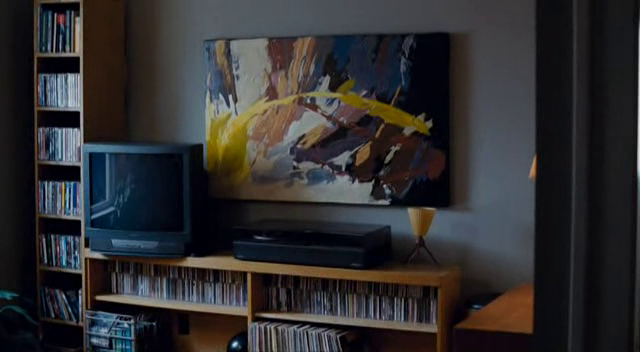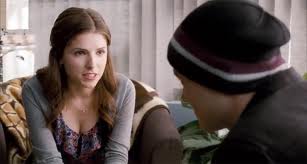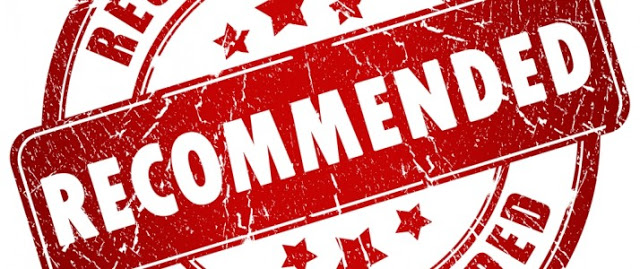When I look at the sloppy homemade label on my screener of 50/50, it looks like it says, “so-so.” Despite solid reviews and the year-end awards nominations, that pretty much sums up how I feel about the movie.
“‘Oppression’ Is in the Bathroom”: 50/50’s Condemnation of Women as Mothers, Artists, and Professionals
 |
| “Liberation” |
This is a guest review by Josh Ralske.
———-
When I look at the sloppy homemade label on my screener of 50/50, it looks like it says, “so-so.” Despite solid reviews and the year-end awards nominations, that pretty much sums up how I feel about the movie.
I’m not one of those people who thinks Judd Apatow is some kind of woman-hating comedy anti-Christ. I mean, the guy is partly responsible for the existence of Lindsay Weir (Linda Cardellini on Freaks and Geeks), one of the richest, most beautifully written and played female characters I’ve ever seen on television. So the presence of massive-erection-concealer Seth Rogen, or the fact that the film was billed as a kind of amalgam of an Apatow-style dude comedy with a serious, realistic drama about facing cancer didn’t put me off the film.
And yet, something did. Even before I saw 50/50, I had this irritated feeling about it. There was something self-congratulatory in the way the film was being promoted, as though the idea of mixing comedy—sometimes bawdy comedy!—with a drama about cancer was something completely new and original, and anyone who doesn’t realize that having cancer can be funny is kind of a square, right? I mean, almost every movie about every disease, except maybe Love Story, has some humor in it. This is a very traditional human coping mechanism. I guess what separates 50/50 is simply a matter of degree.
Well, that, and the fact that screenwriter
Will Reiser was writing from personal experience, and that co-star Seth Rogen plays what I hope is a very fictionalized version of himself in the movie. The film is presented as an honest and realistic depiction of how a serious, likeable young man deals with a potentially terminal illness. Disappointingly, despite its efforts at hip, low-key credibility,
50/50 lapses too frequently into cliché and worse.
Joseph Gordon-Levitt stars as Adam, who works for Seattle public radio, and finds out he has a rare form of spinal cancer that he has a 50% chance of surviving. Adam is the type of guy who takes care of himself and is almost pathologically averse to risk. This is illustrated by his refusal to cross a deserted street against the light, and by his lack of a driver’s license, which he attributes to a high risk of accidental death. Isn’t it ironic, don’t you think etc. The film depicts Adam’s efforts to cope with his illness, and the effects of treatment, as his personal life also undergoes an upheaval.
The film’s honesty doesn’t extend to the knotty issue of the American health care system. Adam doesn’t seem to be especially wealthy, but he lives in a rich person’s fantasy world where no one worries about how they are going to pay for cancer treatments, let alone where the treatment one chooses might be circumscribed by an insurance company’s bureaucracy. I guess I can accept the argument that the film is supposed to be about Adam’s emotional journey, but I assume that the thought of how Adam’s treatment is being paid for will cross other peoples’ minds, as it did mine.
Adam doesn’t seem to have much of a social life. His only good friend is the loutish, abrasive Kyle (Rogen), his mother is a stereotypical overbearing worrywart (Anjelica Huston), and his girlfriend is played by Bryce Dallas Howard, which means we already know she is essentially a monster.
50/50’s treatment of its women characters is more problematic. His mother is apparently well-meaning, but she narcissistically draws Adam’s attention back to herself. While he deals with his potentially terminal disease and the severely debilitating chemotherapy, she makes him feel guilty for not letting her “help” enough. There’s also a key scene where she insults a hospital worker because the waiting room temperature is too cold. She puts her own needs first, instead of focusing on Adam. It’s understandable that he does not want to involve her any more than he has to. This characterization isn’t especially hateful or unrealistic; it’s just a bit hackneyed, and in the context of the film, considered among its other depictions of women, it fits in with a disturbing pattern.
 |
| Anjelica Huston as Diane in 50/50 |
Shortly after Adam is diagnosed, he visits with the hospital therapist, Katherine, played by Anna Kendrick. I have been a fan since I saw her in
Camp. Kendrick is a terrific actor, with a great, naturalistic sense of comic timing, and her scenes with Gordon-Levitt have an energy and charm that elevate the film. Boyish, wounded Adam and sincere, fumbling Katherine are an adorable couple, but the issue is that if Katherine was any good at all at her job, they wouldn’t ever be a couple. Years of education and, presumably, some professional training have left the amiable Katherine, the world’s worst therapist.
I suppose it’s understandable that she’s a bit unsure of herself, and Kendrick plays that uncertainty realistically and appealingly. But again, in the context of the film, the message that comes across is that she is a terrible therapist in part because she is a young woman. One of the stereotypes about young women perpetuated by mass media from its beginnings is that they are excessively emotional. Katherine cannot put her emotions aside in her dealings with Adam. She doesn’t appear to understand basic concepts of transference. If she were a competent therapist, perhaps she would not be put in the position of having to serve as Adam’s only reliable emotional support when he finally does break down. Katherine is a likeable character, largely due to Kendrick’s charm, but we can’t respect her.
 |
| Anna Kendrick as Katherine in 50/50 |
The movie’s biggest prolonged sour note is its conception of the character of Rachael, Adam’s girlfriend. Woody Allen has taken a lot of flack for the characterization of women in his films, and as The Opinioness points out
here, the horrifically two-dimensional, shrewish Inez (Rachel McAdams) from
Midnight in Paris is no exception. The makers of
50/50 seem to have pretty much gotten a pass from critics, however, for the misogynistic creation of Rachael.
This is such a problematic character that I barely know where to begin. She’s a straw man. There’s no compelling reason that we see for Adam to be with her, other than her physical beauty, but Adam is not presented as a shallow man who comes to appreciate a woman’s inner beauty through this traumatic experience. He’s essentially presented as a perfect boyfriend, making all the right moves toward a committed domestic relationship.
But then, Rachael is an abstract painter, and while Adam pretends to be interested in and supportive of her work, it’s pretty clear that he doesn’t actually give a crap. He shows the painting in their living room to his mother, mistakenly calling it “Oppression.” Rachael points out that the actual title is “Liberation,” and Adam remembers that “Oppression” is the painting in their bathroom. Rachael’s high-minded artistic aspirations are essentially treated as a joke, even before we understand what an awful person she is. She’s just a pretty, solipsistic, talentless airhead. Again, this brings up the question (as with Owen Wilson’s Gil in Midnight in Paris) as to what the poor, sensitive protagonist sees in her.
 |
| Bryce Dallas Howard as Rachael in 50/50 |
Naturally, after gamely taking on the responsibility of being Adam’s caretaker, Rachael fails him in every way, at one point leaving him waiting for hours before picking him up after a chemo session, and betraying him with another man. She’s a hateful character. Adam even says to her at one point after they split, as Rachael, now vulnerable due to career troubles, is trying to apologize and reconcile with him, “I’m sorry I didn’t come to your opening. It’s just ’cause I hate you so much.” This, and a subsequent scene in which Kyle and Adam destroy Rachael’s painting, “Liberation,” are clearly meant to be cathartic moments for the audience. We’re not meant to have any sympathy for Rachael.
 |
| Seth Rogen as Kyle and Joseph Gordon-Levitt as Adam in 50/50 |
Kyle also fails Adam, manipulatively and opportunistically taking advantage of Adam’s condition to aid his own pursuit of impossibly credulous young women. Kyle is essentially an asshole. He treats women condescendingly (and this is always presented as humorous and without negative consequences for him), and he’s often insensitive to Adam’s needs. But as with Rogen’s character in Knocked Up, Ben Stone, the presence of a few appropriate self-help books in Kyle’s apartment serve to indicate that, well, at least he’s trying. Like Rachael, Kyle tries and fails to be what Adam needs him to be, but, in the filmmakers’ view, Kyle is redeemable, and Rachael is not.
50/50 has its low-key charms, and moments of grace, many provided by Kendrick, but the question that continues to nag at me is: Why is it necessary for a purportedly realistic film about a young man dealing with cancer to have a cartoonishly evil villain?
———-
Josh Ralske is a freelance film critic based in New York. He has written for All Movie Guide
and Critical Mob.







